There’s no question, the brand building process has evolved.
Building a brand in the twenty-twenties is no longer the same as it once was.
Unfortunately for most businesses, consumers aren’t mindless moths with shiny object syndrome.
Nope, they’re smarter than that, and they’re getting smarter.
They have real challenges standing in the way of real goals and a good looking logo simply isn’t enough to get them over the line.
If you want to influence their buying decision, you need first understand them, then build a brand around them.
In this article, you’ll discover an in-depth 21-Step Brand Building Process to build a successful brand in 2022.
What Is A Brand?

Chances are, this isn’t your first rodeo and you’ve got a solid idea of what a brand is.
But the meaning of a brand can be different from one person to the next so let’s start with a simple definition.
A brand is an entity developed by a business to shape the perception and build the reputation of the business in the market.
What Is Brand Building?

So now that we have the definition of a brand in place, what is brand building?
Well, building a brand or “brand-building” is the activities undertaken by the business to actively shape that perception and build that reputation.
They do this by creating strategic communication and experiences across all touchpoints.
Building a brand doesn’t happen overnight.
It happens over time by communicating a consistent message and then consistently delivering on the promise the message conveys time and again.
This is how reputations are developed and this is how brands are built.
PRO Brand Strategy BluePrint
Build Brands Like A Pro Brand Strategist

The Three Pillars Of Building A Brand

When it comes to forging an effective brand, there are three core pillars that the brand is built upon.
Overlooking or under-developing any one of these pillars and the chances of branding success are significantly reduced.
Explore Brand Strategy
Programs & Tools
Brand Strategy

The strategy phase is all about clarity.
Specifically, it’s about defining
Who we are
Who we’re for
Why they should they care
How we’ll show them
Most businesses simply skip this step and so their identity and marketing lacks the clarity needed to really influence.
Once you’re clear on these key questions, the brand building process becomes so much easier.
Brand Identity

The brand identity is probably the most well represented branding pillar across all businesses because quite simply, very few businesses in the world don’t have a logo of some kind.
But the identity system itself is more than just a logo.
The term “system” refers to the individual visual elements of the brand all working together in cohesion.
The visual branding elements are designed to communicate the attributes of the brand visually.
Brand Marketing
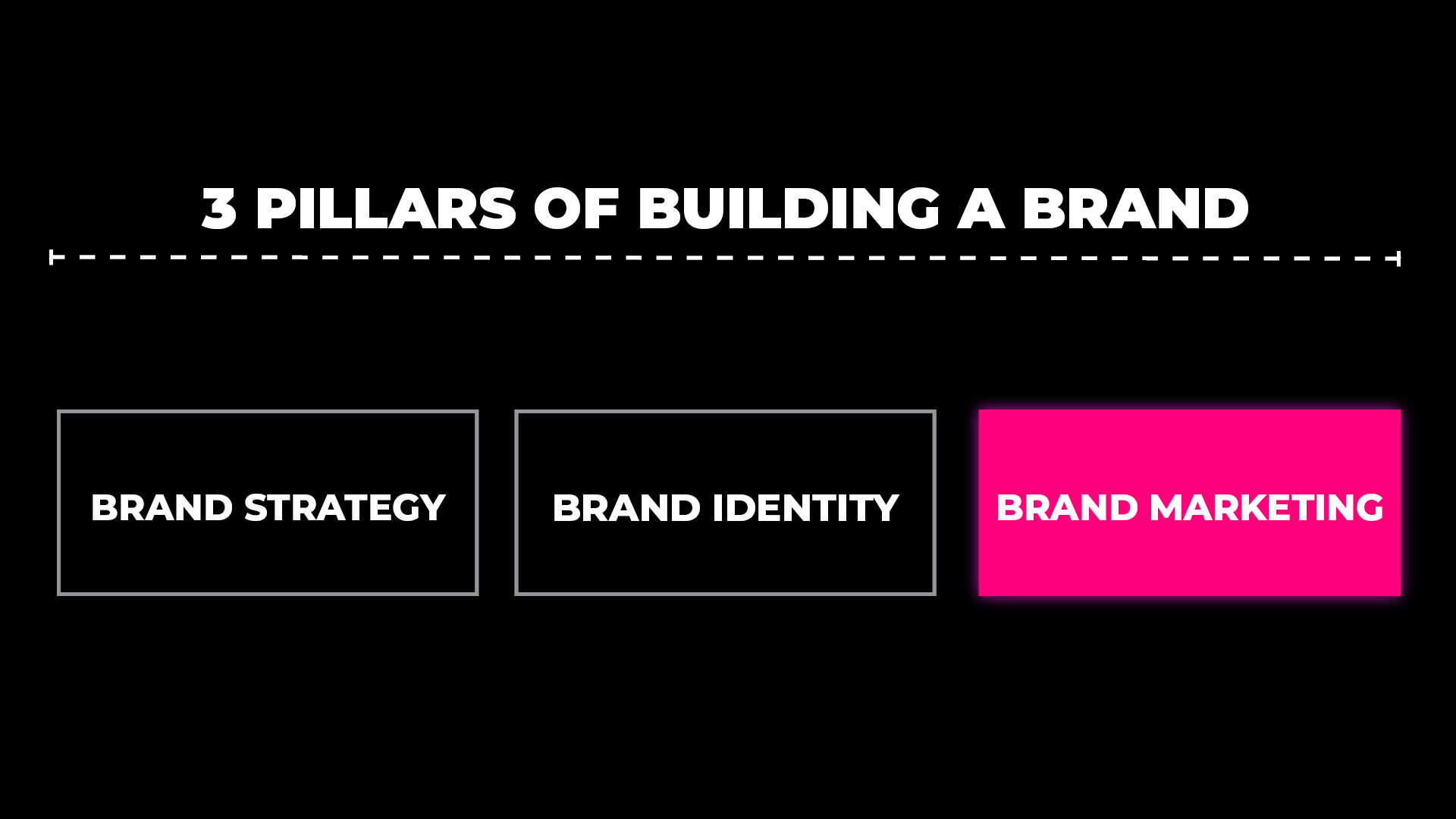
Branding without marketing is like an engine without fuel.
You can have the best product or service in the world, an enticing position, a compelling message, and an engaging identity, but unless you have the means to get your brand in front of your audience, it doesn’t matter.
Marketing is where the rubber meets the road and the message of the brand is delivered across a variety of touchpoints which can include
Social Media Profiles
Websites
Environmental
Point-Of-Sale
Advertising
Content Marketing
Videos
Email Marketing
Seminars
Industry Events
Printed Material
Importance Of Brand Building

The importance of brand building is regularly overlooked.
I’ve heard overly optimistic entrepreneurs stating that their idea was so good, that they just needed to “turn on the marketing” for guaranteed success.
Needless to say, I’ve never come across a business that found branding success by simply “turning on the marketing”.
For any marketing tactic (let alone strategy) to have success, it must be finely tuned to the brand it represents.
The more accurately tuned marketing and branding are, the more likely
the right message will be delivered
to the right audience
with the right method
Only when a business can achieve these things can the build an actual brand that will grow over time.
The 21-Step Process For Brand Building Success

If you’re building a brand for yourself or for your clients, having a solid brand building process in place is critical.
The following process is used by some of the biggest and most successful branding in the world.
Follow this process step-by-step and adopt it in your own business or agency to build brands that connect with their intended audience.
#1. The Human Brand – Build An Entity To Connect

This first step to this process is an important one.
It’s shifting the mindset to what you’re actually building.
Most people think of building a brand as a visually appealing representation of their branding though we connect with brands in the same way we connect as people.
As people, we connect with others through the signals they send including their looks, their style, their traits, their behaviour, their personality and their communication style to name a few.
So don’t think of building your brand as building a corporate entity.
Think of it as building a human entity designed to connect with other humans.
#2. Brand Purpose – Start With Why

As people, we’re all very different.
But one of the traits that make us similar is our need to feel like we’re here for a reason and that we serve some kind of purpose.
If you know what your purpose is, and you spend your days living that purpose… the work you do doesn’t feel like work at all because you’re living your purpose.
Purpose driven brands attract personnel and customers who believe what the brand believes.
Simon Sinek’s Ted Talk “Start With Why” which is an overview of his book outlines how brands that know their why, are much better positioned to serve their audience.
To find your brand’s purpose, identify why the brand exists beyond money.
#3. Brand Vision – Define The Future Brand
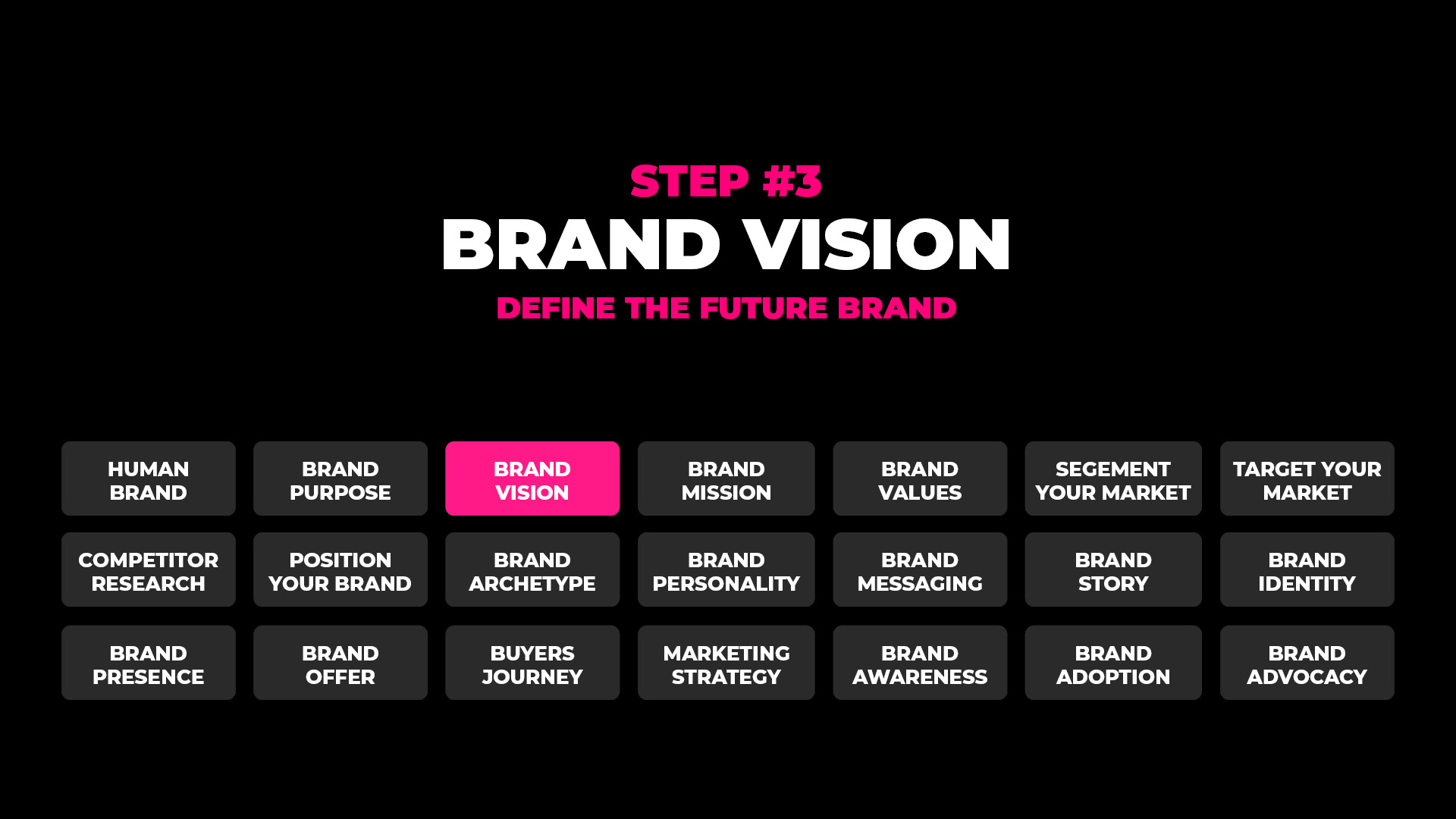
No one attempts to build a brand to fail.
Every brand is built with aspirations of success though most brand leaders never take the time to really think about what success looks like.
As Stephen Covey famously said in his best-selling book 7 Habits Of Highly Effective People
To begin with the end in mind means to start with a clear understanding of your destination so the steps you take are always in the right direction
Brand’s and brand leaders who understand exactly where they want to go can make better decisions to get the brand to it’s destination.
For your brand to stand a chance of success, first, get clear on what success looks like and document it in your vision statement.
#4. Brand Mission – Outline The Brand’s Commitments
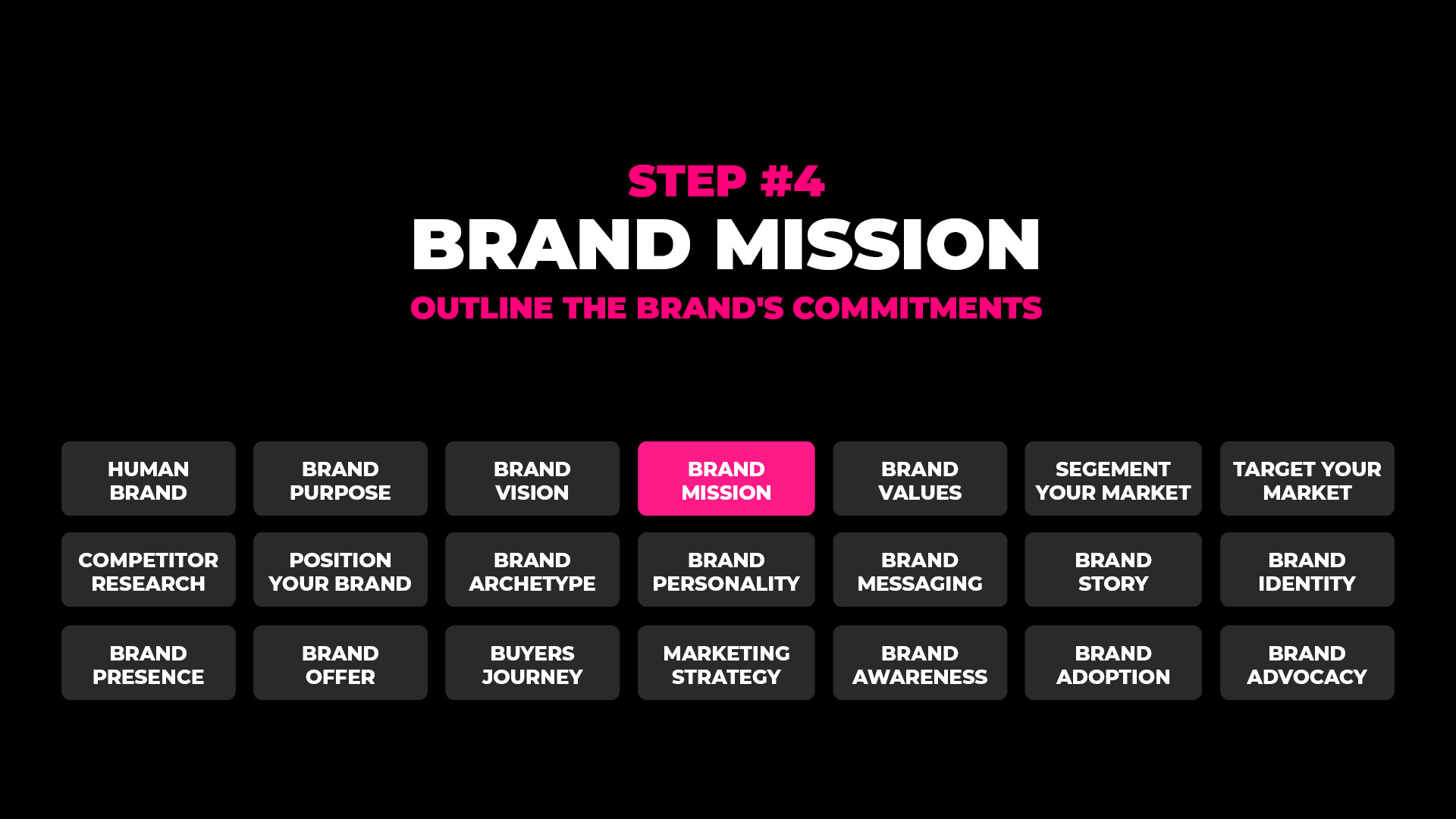
A brand’s mission represents the commitments the brand will undertake in order to achieve it’s aspirational vision for the future.
Now when I say commitments, we’re not talking about a to-do list of tasks the leadership team should tick off.
Instead, the mission of the brand is a commitment to deliver a specific something in a specific way that distils the brand’s philosophy.
As in
This is the way we do things round here and we’re committed to doing it this way
Brands that are driven by passionate leaders who are truly committed to their mission develop a reputation for that philosophy.
Get clear on what your brand’s philosophy is and how would you specify your commitments as a brand.
#5. Brand Values – Define How You’ll Show Up
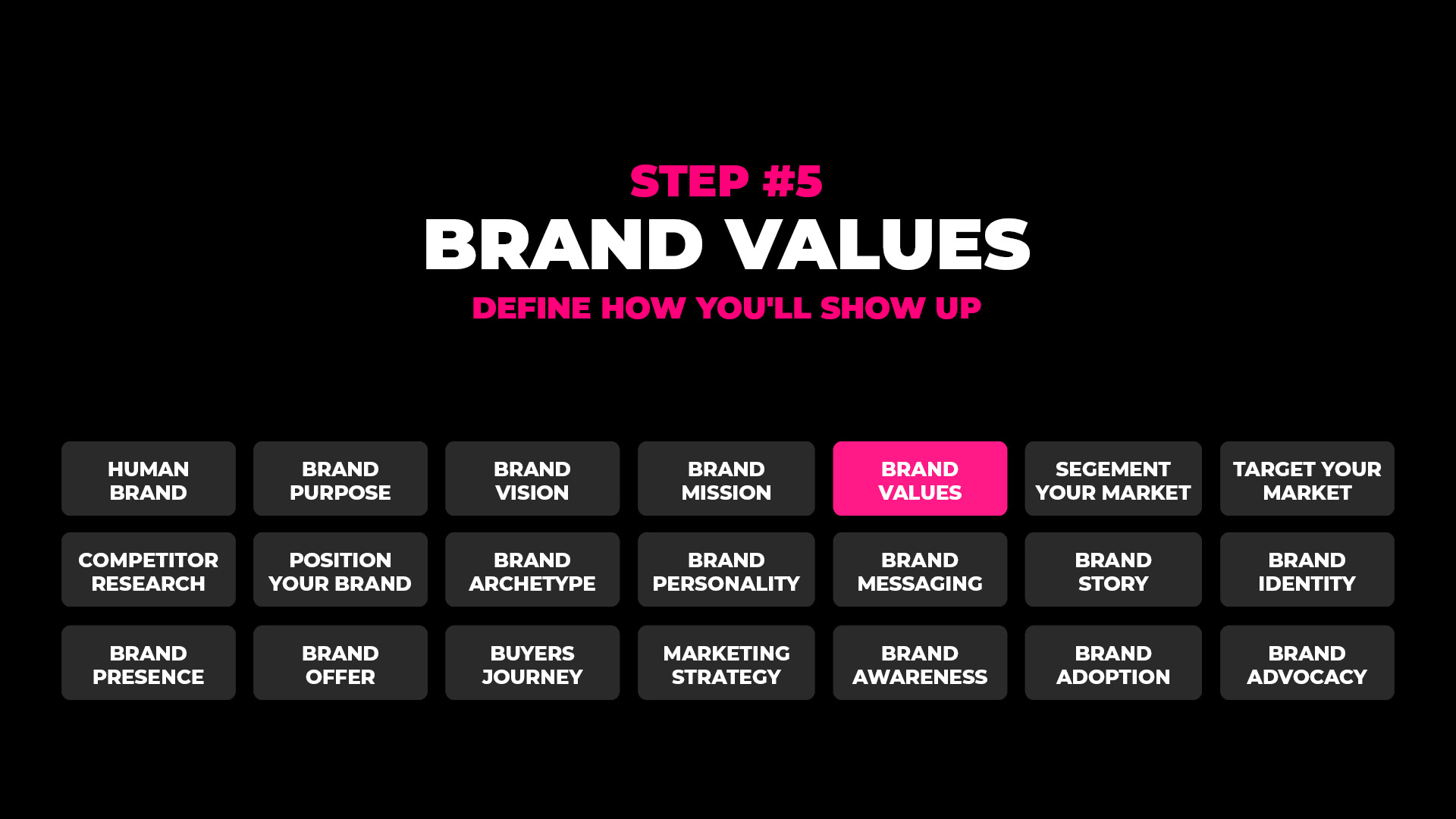
As people, we tend to gravitate towards other people who have the same values we have.
The more aligned we are with others in our values, the more likely we are to have grounds for a strong connection.
Brands that display values which are aligned with their audience, create a solid foundation for customer relationships.
Brand values have been misused by businesses and aspiring brands for years as marketing.
But values are not displayed in our words. They’re displayed in our behaviours.
In order for brand values to be effective, they must first be actionable and then they must be acted upon.
Brand values are not a marketing tool. They define what the business holds dear, how they’ll show up to the market and they should influence business decisions.
Get clear on what’s important to you in the way you do business, then create concise actionable statements to use as a guide.
#6. Segment Your Market – Identify Market Consumers
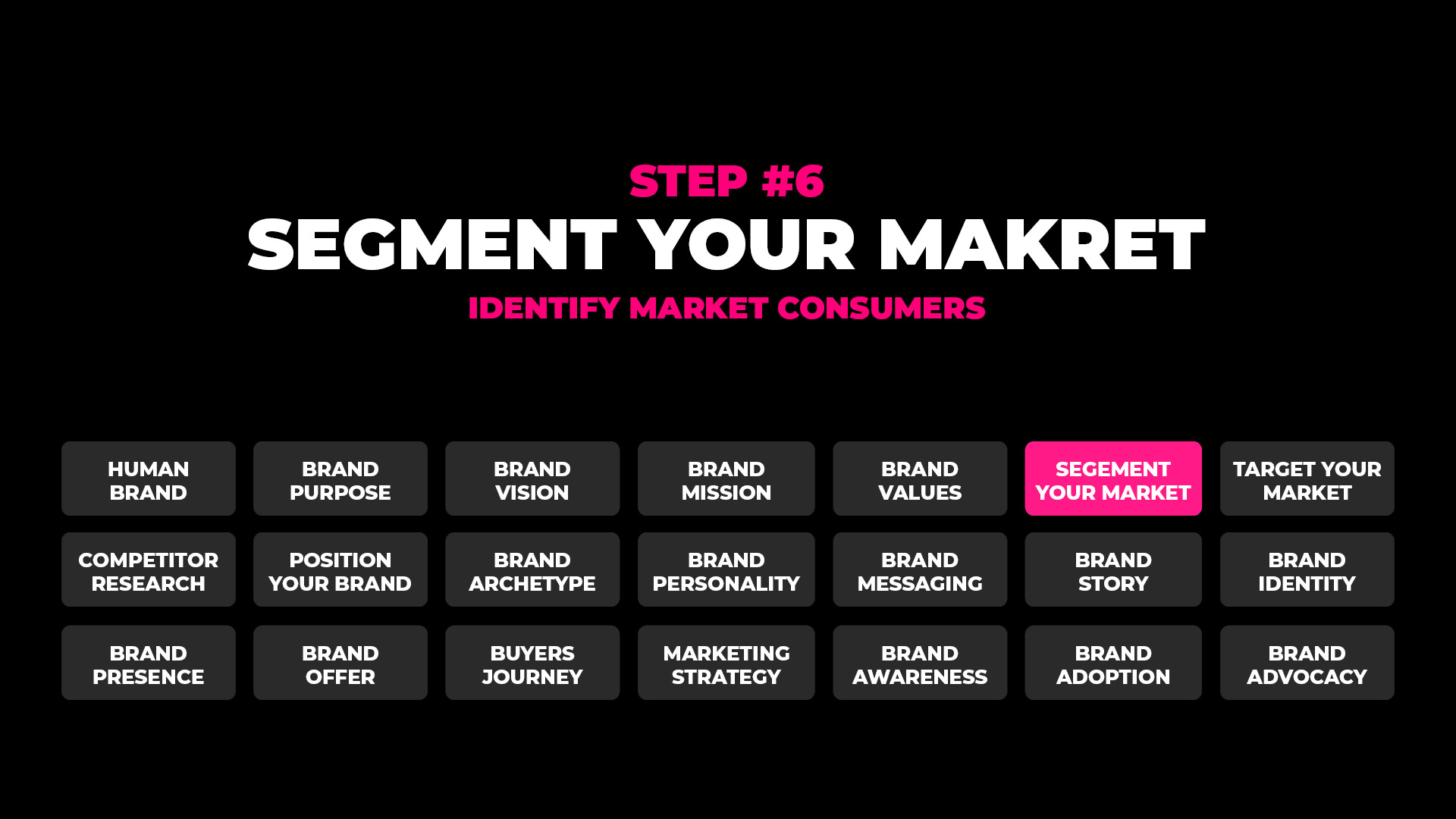
Markets are simply groups of people who want or need what businesses are offering.
When we refer to the technology market, we’re referring to the groups of people in the market for technological goods or services.
When it comes to strategically defining the brands plan, the first port of call is to identify the market and the segments within it.
A physiotherapist needs to understand the segments that make up the market of people who are looking for their services.
For example, there are different groups of people in the market for a physiotherapist.
These groups include
People recovering from an injury
People who play sports
People with back & neck problems
Pregnant women who need relief
Children with developmental challenges
Each one of these groups is a segment in the market which the physiotherapist needs to understand before defining who they want to help.
The same is true for any other business and any other market.
One of the most important steps in the brand building process is determining the existing market segments. Understand the different groups of people in your market and what makes the people in each group similar.
#7. Target Your Market – Identify Your Ideal Customers
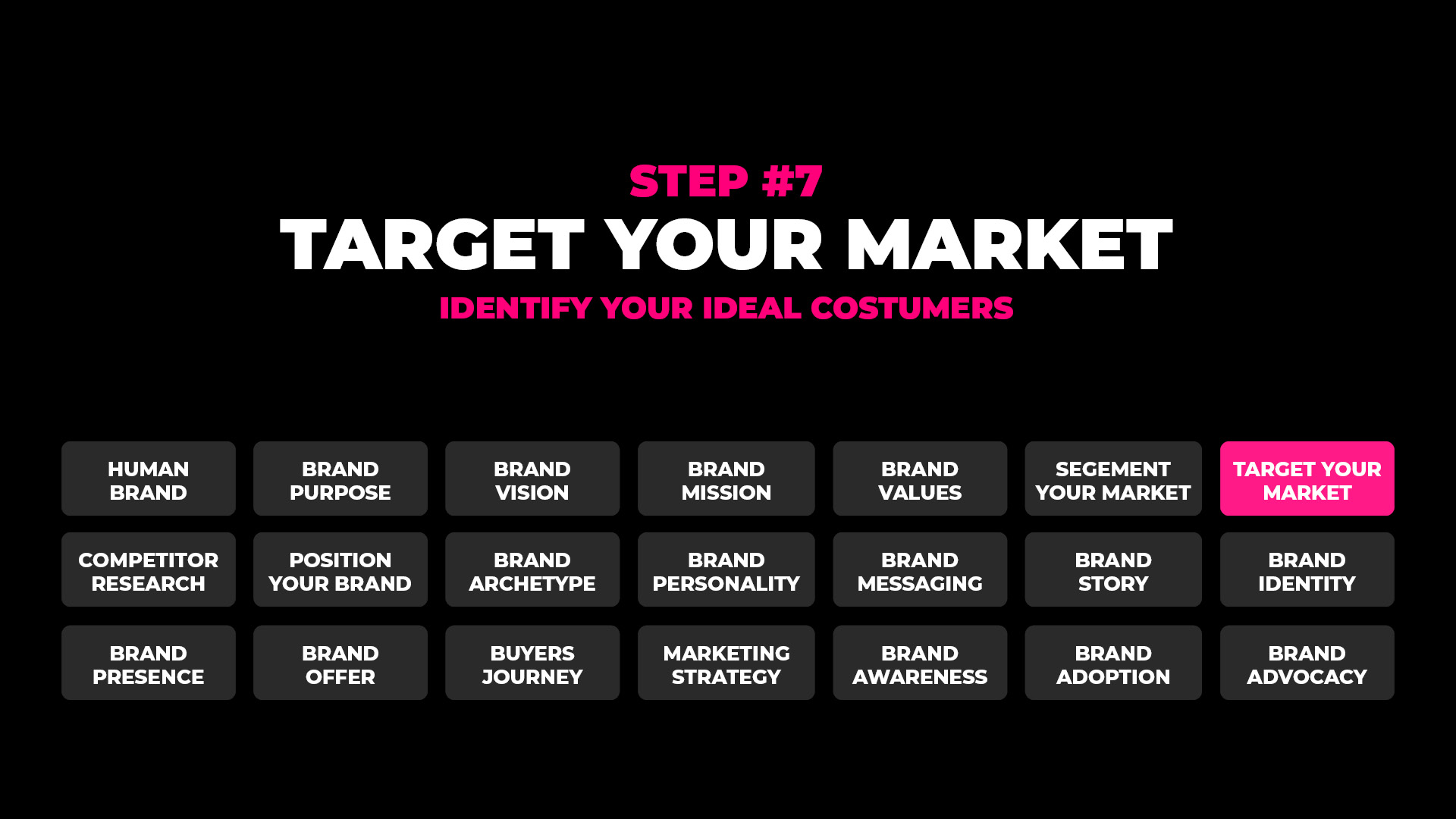
The next strategic brand building step is to get clear on the brand’s target market.
These are the groups or segments of the market the brand wants to target.
Using our physiotherapist again as an example, although she could probably help everyone in the market for a physiotherapist, targeting everyone is often a poor strategy.
Getting crystal clear on the exact segments she’s better placed to target, will likely achieve more traction and better results.
For example, if the therapist is a mother and has specialist training in Women’s Health Physiotherapy, chances are, she’ll better resonate with that market segment than others.
Once you’ve identified the segments that make up your market, define which group of people you want to target and how or why you may be more relevant to them.
#8. Competitor Research – Analyse The Competition
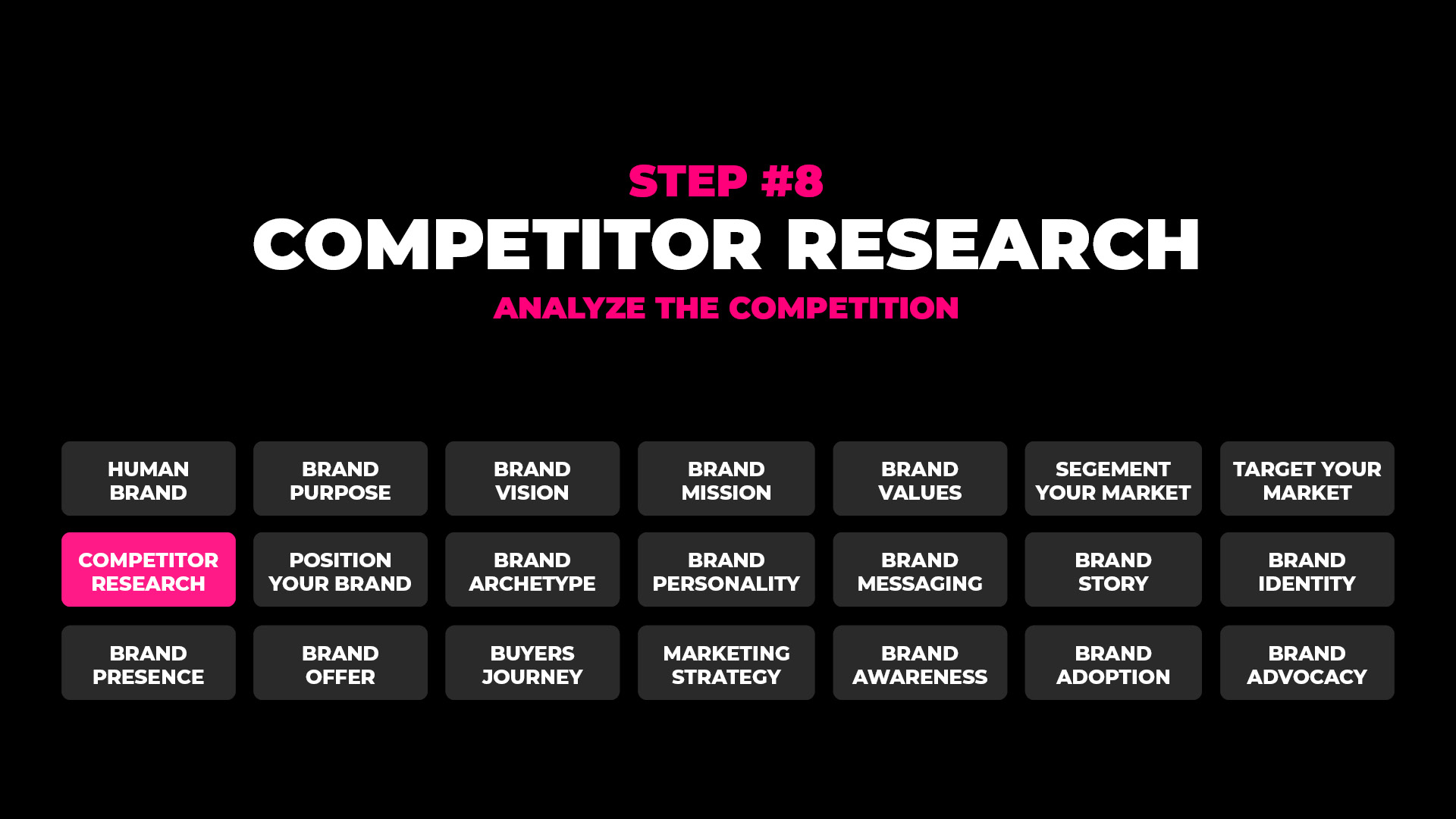
With a clear picture on the segments that make up your market and how you’ll target those segments, the next brand building process step is to understand the brand’s already serving your target audience.
Competitor research allows you to analyse the competition to uncover what your competition is doing well, but most importantly, where they’re leaving gaps.
The reality is, many business owners look to their competition as a roadmap for success, but replication is not the end-goal of competitive analysis.
This step in the brand building process is about uncovering opportunities to be different or more relevant to your target markets’ wants or needs.
Effective competitive analysis is about uncovering unique opportunities to give the audience an alternative option to the ones they currently have.
So take the time to analyse your competitors to uncover unique ways you can give your target audience something a little different.
#9. Position Your Brand – Define How You’re Different
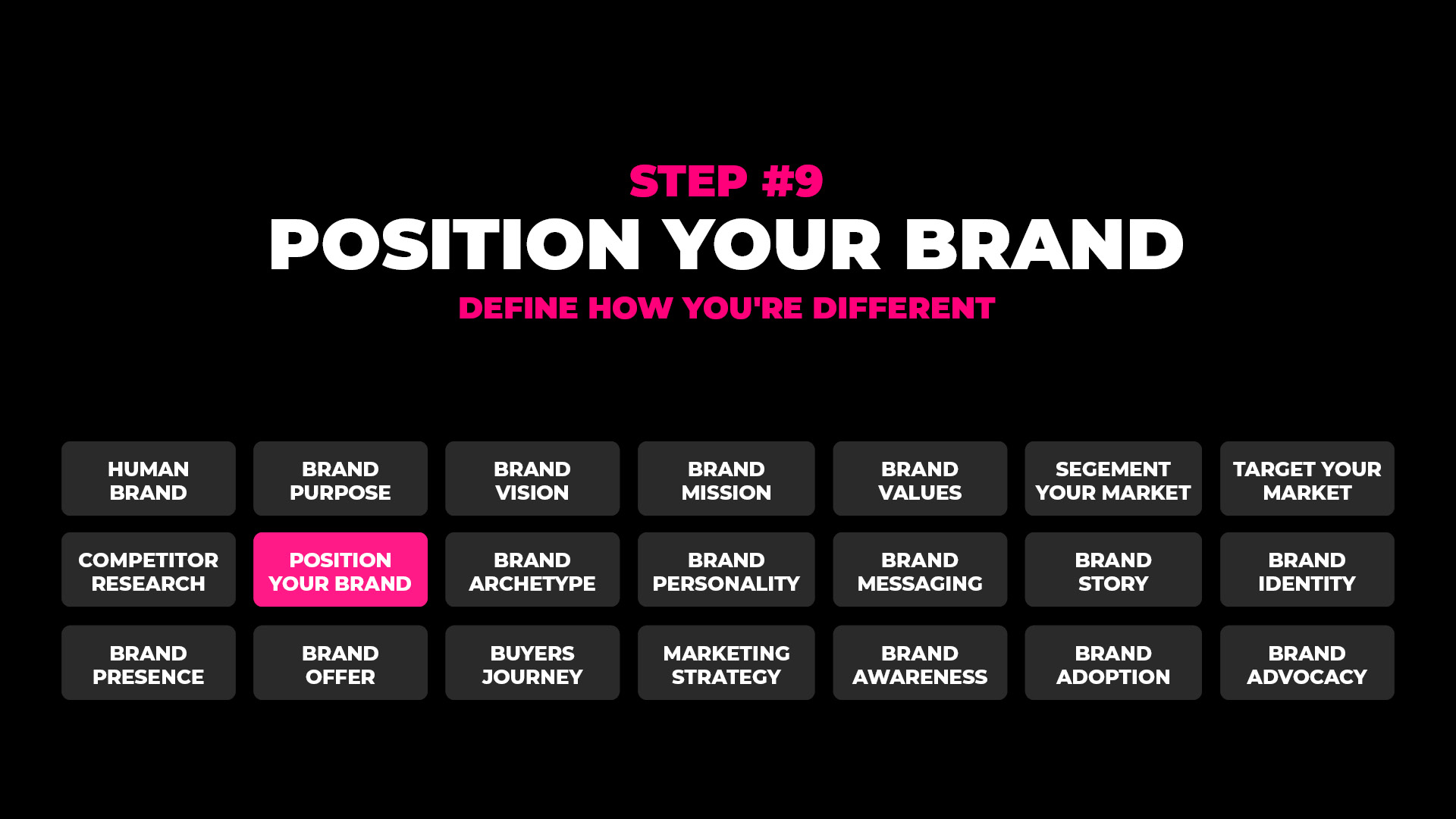
Brand positioning is where the rubber meets the road in the strategic brand building process.
At this point, you’ll have done some heavy lifting in the research and analysis of your market, the segments you want to target and the competitors already serving them.
Now it’s time to define the reason you’ll provide your audience to choose your brand over the competition.
Your differentiation strategy (as in, how you’re different to the competition) outlines the unique-point-of-difference your brand offers in the market.
As a rule of thumb, the more your audience values this difference, the more likely they are to choose your brand or better yet, choose to pay a premium for it.
Not every brand or every strategy can achieve radical differentiation, though the more unique your experience is, the more chance it has gaining traction.
When defining your position, don’t play it safe. Go all out, be bold and don’t be afraid to ruffle the feathers of your competitors.
#10. Brand Archetype – Uncover The Brand’s Personality Type

Archetypes are a scientific framework of personality types developed by psychiatrist Carl Jung in the early 20th century.
The framework provides a foundation of all personality types which brand strategists and leaders can use to develop a personality for their brand.
To use this framework effectively you must first, identify the personality of your audience and second align it to the personalities most likely to attract that audience.
Brand archetypes are not to be used as a standalone technique when it comes to defining a brand personality.
The framework is simply used as the foundation on which the personality is developed.
So take the time to understand the 12 personality archetypes, understand where your audience sits how your brand can align.
#11. Brand Personality – Create A Tangible Personality
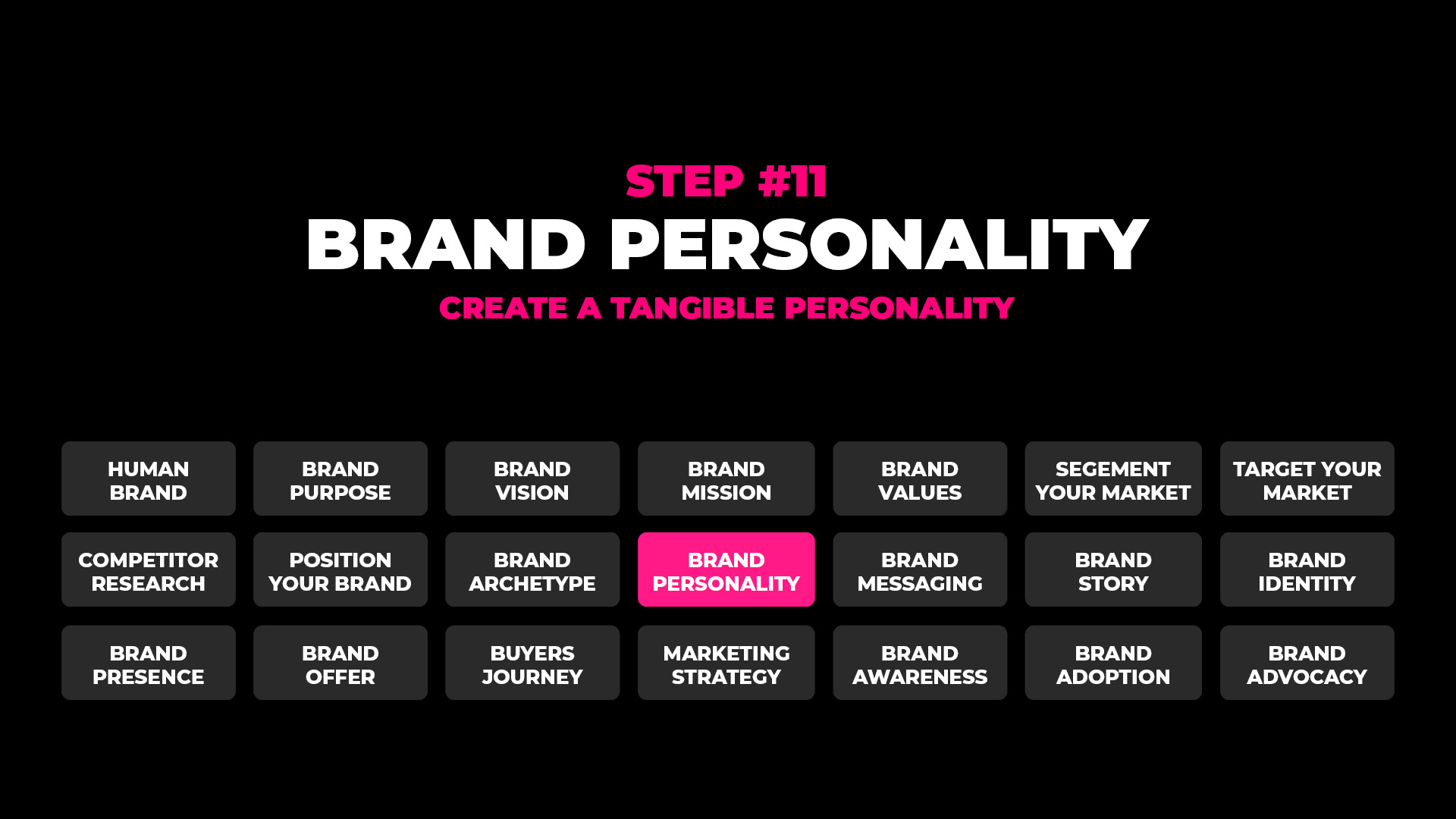
The personality of a brand has become increasingly important in the last ten years.
In the 90’s very few brands had much of a personality and brand messaging across the board came across as robotic and corporate.
Today however, more and more brands are letting their hair down and loading up with personality to endear themselves to their audience.
If you want to see how some of the most successful brands use personality in their messaging then look no further than brands such as Harley Davidson, Red Bull, The Dollar Shave Club, Old Spice and Diesel Jeans to name a few.
These are brands that understand their audience, how they speak and the attributes that get them excited, which just so happen to be the attributes these brands are built on.
When you’re ready to bring your brand to life as a walking, talking, charming representation of your business, identify the traits that get your audience in the mood and generously season your messaging with them.
#12. Brand Messaging – Craft A Core Message & Framework

Good looks, noble values and charming personality aside, when your brand gets it’s chance at the podium, it had better have something relevant and enticing to say.
And this is where most businesses and brands get it wrong.
They pour half their time, effort and budget into making their brand look and the other half to Google or Facebook for their chance on stage.
And when they finally get there, they’ve got very little to say of any influence.
It’s only when you really take the time to understand your audience, how they’re feeling and what they really desire you can craft messaging that taps into their emotional brain.
Despite the countless articles around “core message” directing you to create a body of text, your core message are a collection of key messages that work together to shape the perception of your brand over multiple touchpoints.
So define the perception you want to create and craft the framework of messages that will work together to shape it.
#13. Brand Story – Define A Stoytelling Framework
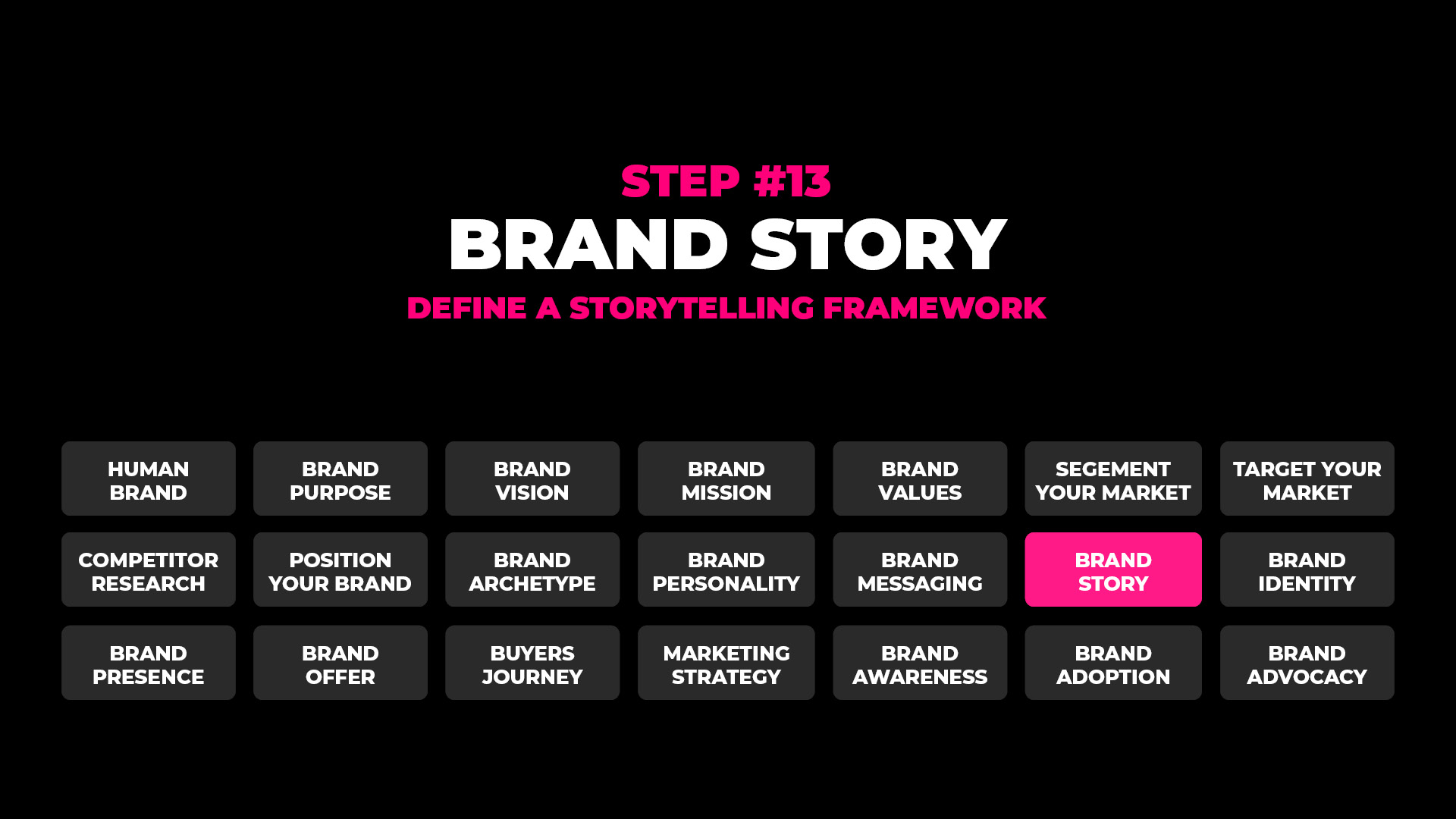
The human brain is wired for story.
If you don’t believe me, check out this Ted Talk by Neuroscientist Uri Hasson on how the brain responds to story when compared to factual information.
Our brains are wired for story because complex language, the written word and manuscripts are all relatively new in the grand scheme of things.
For millions of years, stories were the only effective way that people could pass on knowledge and wisdom from one generation to the next and so it has become part of our DNA.
When we hear a story, we’re hardwired to find out the resolution so we can learn from the journey of the protagonist.
Brands are able to leverage this hardwiring by crafting stories about their audience, the journey they’re on, the challenges they face and ultimately the outcomes they seek.
So step into the shoes of your audience, bring the journey to life and craft a narrative of success that looks, sounds and feels just like the audience it was written for.
#14. Brand Identity – Design A Brand Identity System
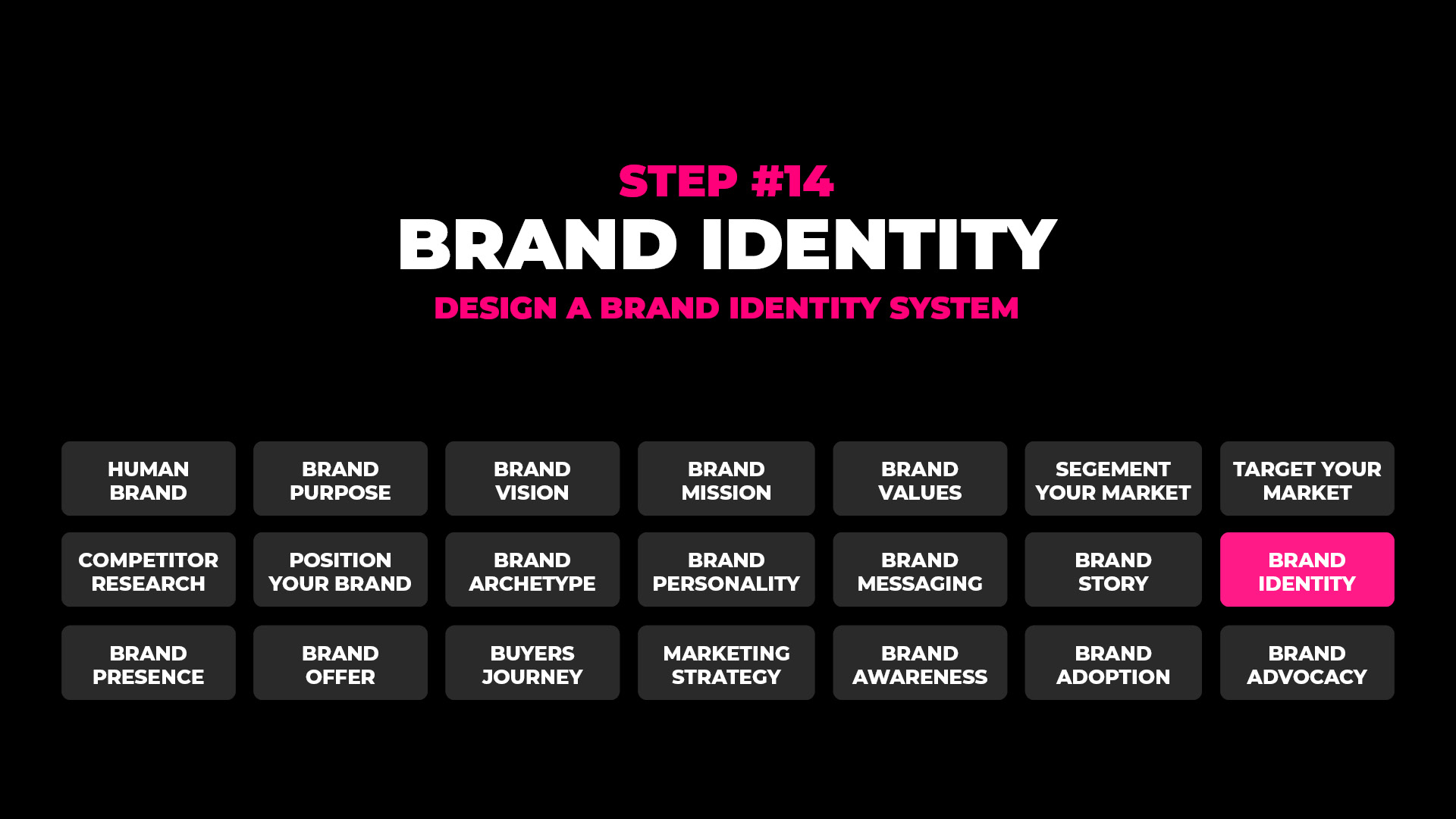
At this stage, the whole “A brand is not a logo” headline has had its day in the sun.
Most business owners understand that they need a strategy behind their brand to have any success.
But as much as we might speak about the importance of a strategy, it can be easy to overlook the importance of the visual brand.
There is no form of communication quite like visual communication.
Visuals by-pass the complex analytical part of our brain for processing in milliseconds by our primitive reptilian brain.
The brand identity therefore provides the opportunity for the brand to get the foot in the door long enough to make an impression.
There are many brand identity elements at play in a well-designed system including
The Logo
Typography
Colour
Image Style
Icons
Motion Graphics
The more strategic and cohesive these elements are, the more impact they’ll have on the brand experience.
So bring the strategy work to the table when designing your brand identity and lead with the traits that get your audience in the mood.
#15. Brand Presence – Create The Brand’s Assets
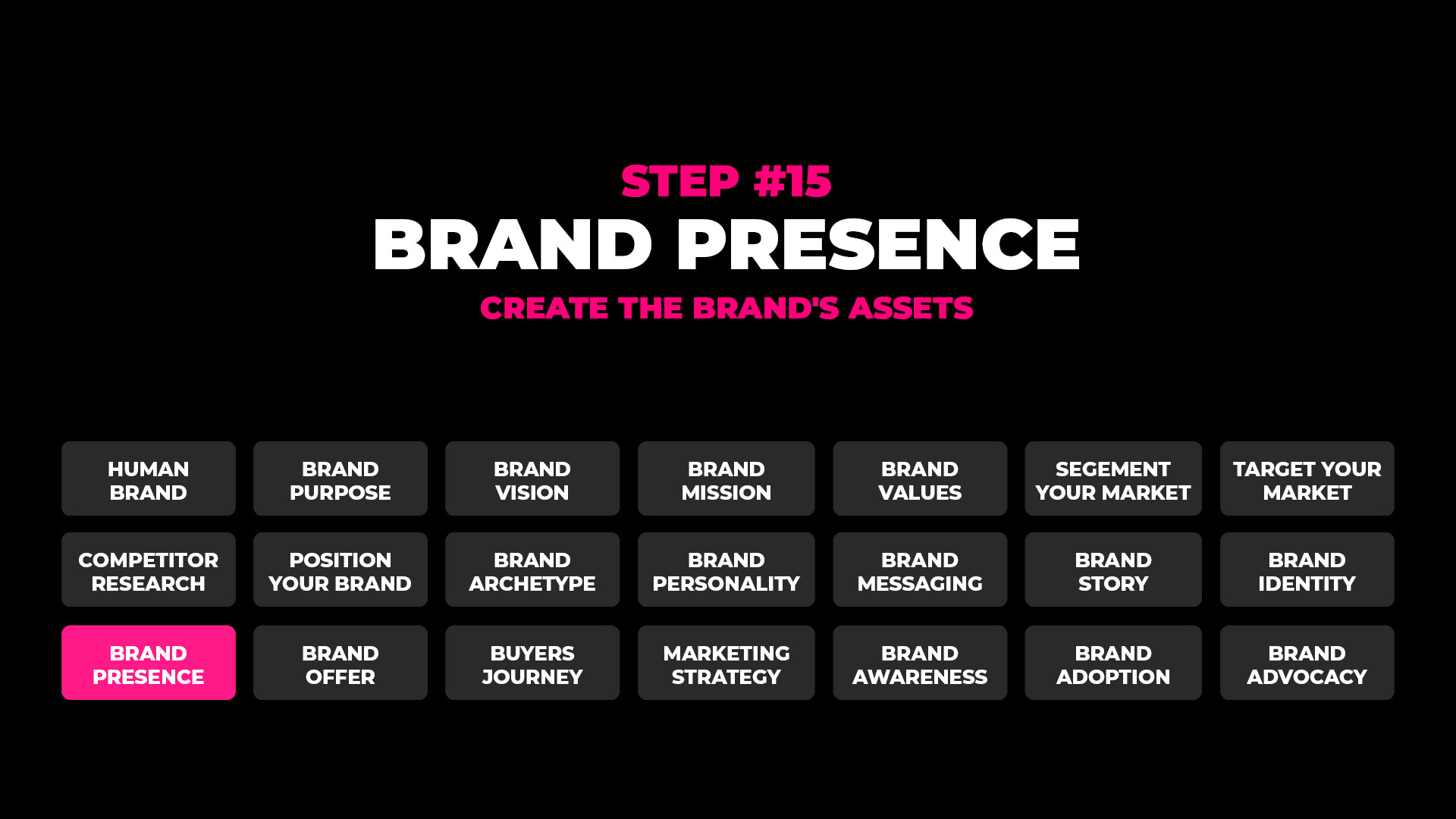
Once you have a well-designed brand born from strategy, it’s time to bring the brand to life in the digital and physical world.
A brand is not a physical thing.
It lives in the mind as a perception, though it needs a presence where your audience congregates to shape that perception.
Today, that presence can be created in the digital or the physical world and can include:
Websites
Social Media Profiles
Blogs
Video Platforms
Environmental Designs
Point-Of-Sale
Brochures
Business Cards
Vehicle Wraps
And Many more
So define the environments where your brand will engage with your audience and design the assets that can most effectively deliver your brand message.
#16. Brand Offer – Create A Compelling Offer

The brand building process clearly defines who the brand is for, why it’s different and why the audience should care.
But once groundwork has been laid by the brand’s strategic messaging over multiple touchpoints, the brand’s offer then plays an influential role in the buying decision.
How a brand’s products or services are packaged up into a compelling offer is often the difference between a visitor converting or not.
More often than not, the challenge your audience is trying to overcome is not in isolation and is often coupled with other challenges.
The more relevant challenges addressed, the more compelling the offer.
Brand’s that can creatively package their products into an offer that helps the audience to overcome multiple challenges provides a convincing argument that all the obstacles on their path have been considered.
So think about what your audience is actually trying to achieve and what other challenges you can help them remove to increase the perceived value of your offer.
#17. Buyer’s Journey – Forge Your Funnel Steps
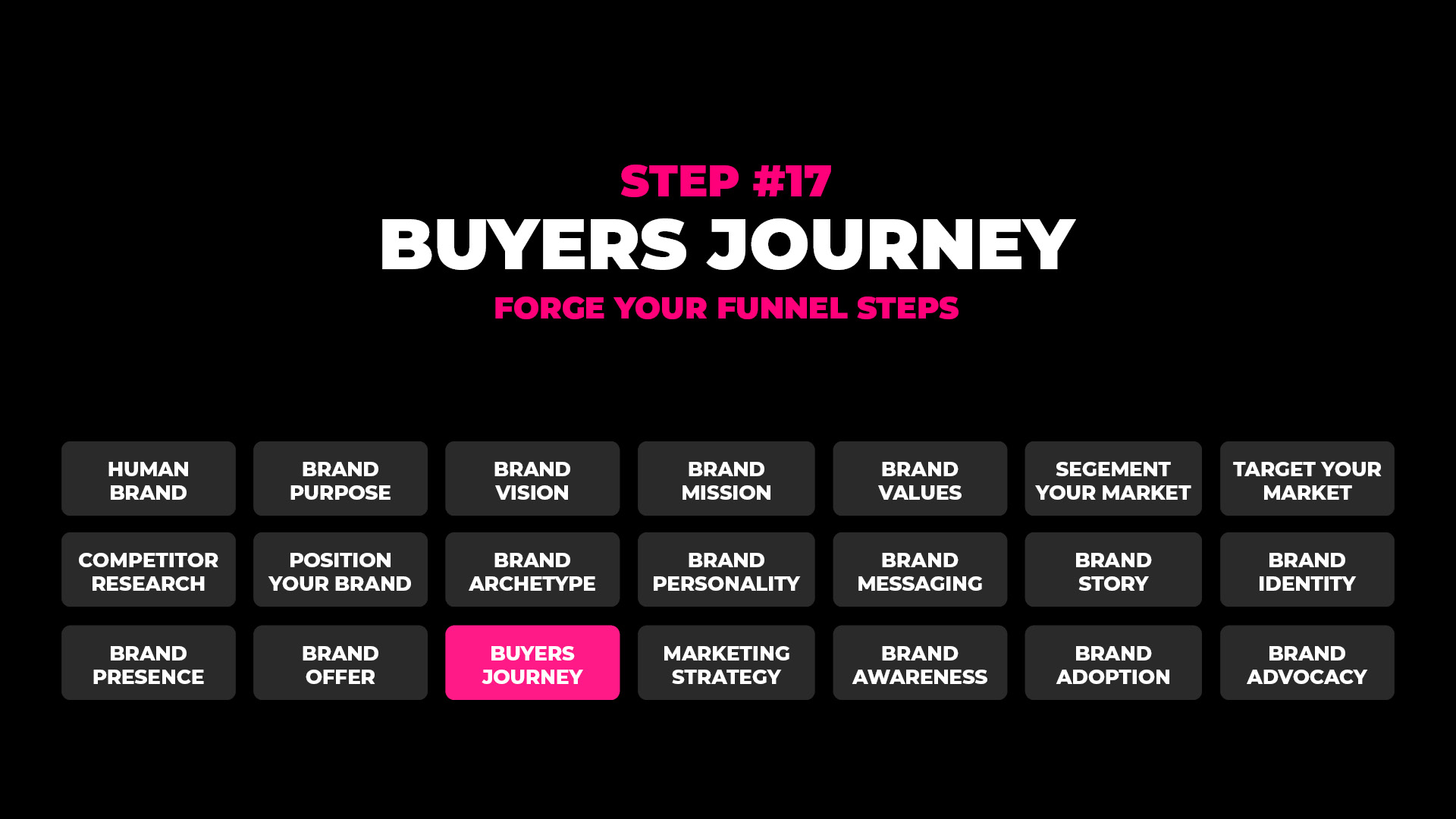
The buyer’s journey is different for every brand but every brand has a buyer’s journey.
These are the steps your audience typically takes en route to becoming a customer.
As a rule of thumb, the higher the price point of the product or service, the longer the buyer’s journey.
Ultimately, your brand needs to guide your audience from the cold outer periphery where they know little to nothing about the brand, to the warm inner circle where they choose it over the competitive alternative.
To do this effectively, you must understand the emotional state of the audience at each step, the questions they have and what they need to progress to the next step.
An effective sales funnel maps the buyer’s journey and offer interesting or valuable breadcrumbs to entice the user to progress one step at a time.
So step into the shoes of your audience, identify the questions they have and craft an engaging funnel to guide them through the buyer’s journey from a cold lead to a hot new customer.
#18. Marketing Strategy – Create A Plan For Marketing Execution

Armed with a strategic message, an engaging identity a compelling offer and an enticing funnel, your brand is ready to be amplified to the world.
Your marketing strategy is your brands plan to identify where your audience congregates and how to place the right message in the right environment at the right time to influence perceptions and ultimately action.
As we’ve already covered, every market is different and where people go for their passion, learning, entertainment or curiosity varies drastically.
The platforms, media and tools at a brands disposal can include
Organic Social Media
Search Engine Marketing
Television
Digital Display Networks
Billboards
Paid Social Media
Print Advertising
Radio
Blogs
Search Engine Optimisation
Events
While many of these platforms and tools are pay-to-play, many are attainable with time and effort rather than budget.

Of course, the paid platforms are more immediate and guarantee eyes on your message while the organic options take longer with no guarantees.
For example, writing an article on your blog might only cost you the time it takes to write and post the article though that article will take much longer to attract searchers when compared to a Google ad which guarantees one of the top spots.
Creating your marketing strategy is about prioritising budgets and congregations to find the right balance of engagement for your brand.
So identify, where your audience is, what they’re looking for, the type of media or message to engage and the resources at your disposal to define a marketing plan for your brand.
#19. Brand Awareness – Raise The Awareness Of The Brand
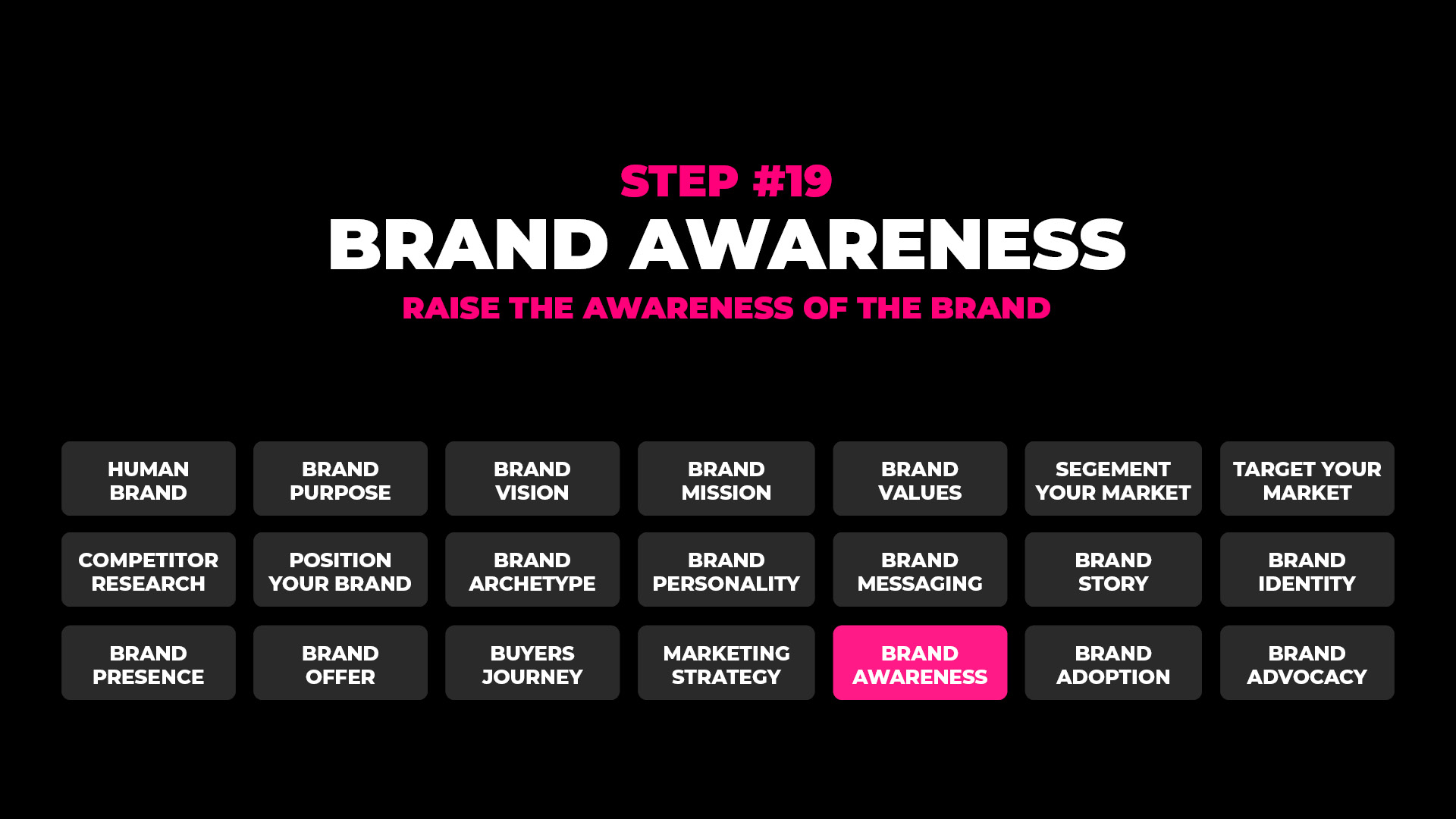
Once all your ducks are in a row, and your brand is launched it becomes a game of balance between consistency and optimization.
The first goal is brand awareness.
When a brand is launched, the market most likely doesn’t even know it exists and raising brand awareness aims to change that.
The more people within your target market that are aware your brand exists, the more chance your brand will be remembered in the buying decision.
Identifying the congregations of your audience is the key to making your brand awareness campaign as efficient as possible.
It’s not about spreading your message as far and wide as possible.
It’s about getting your message in front of as many of the most relevant people as possible.
So focus you brand awareness campaign channels and double down on your efforts to raise that awareness.
#20. Brand Adoption – Increase Conversion Rates
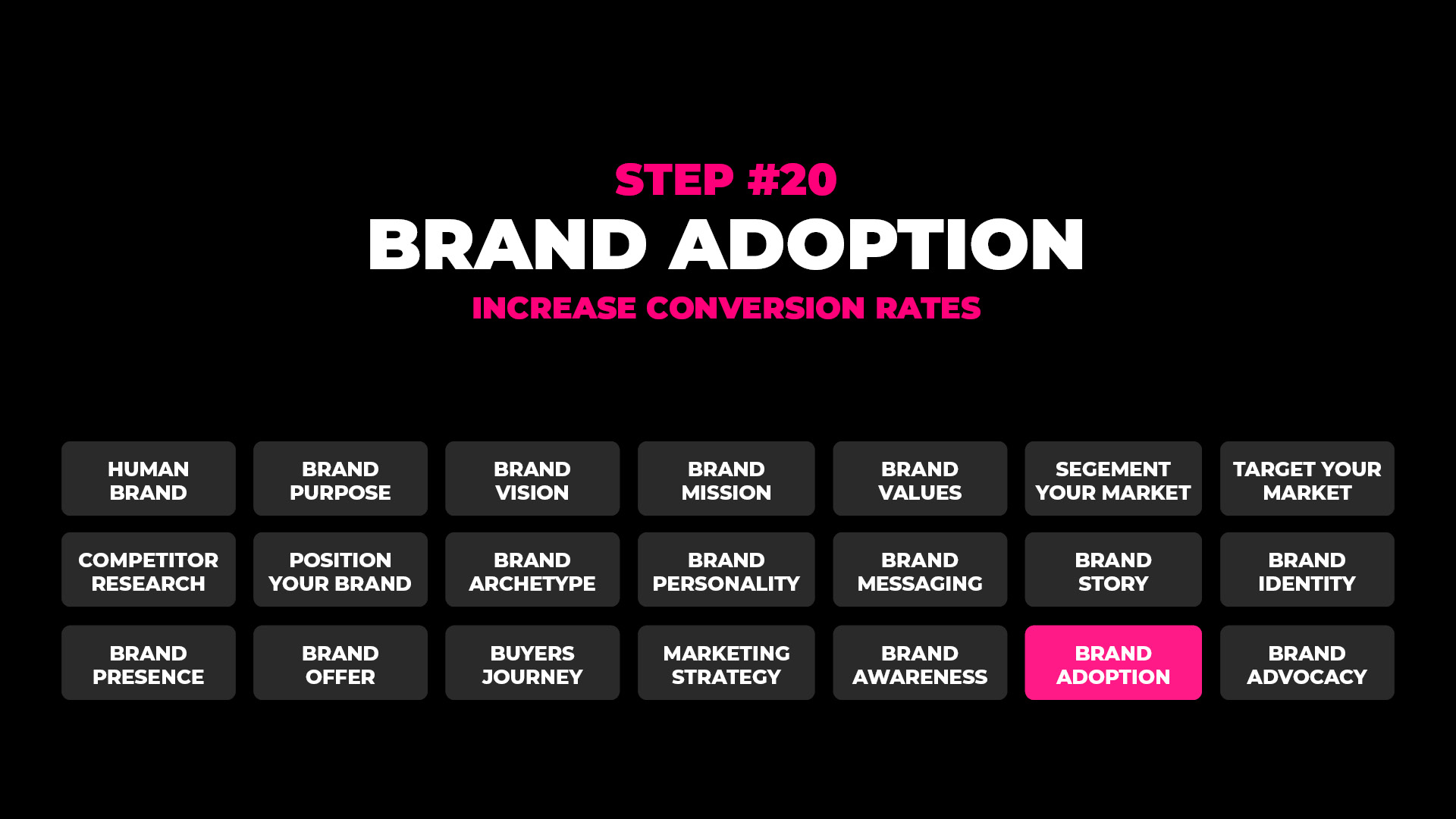
Once your brand starts to gain awareness, the visitors will follow.
Whether that’s to your website or your retail store, making the most of these visitors is a game of conversion optimization.
Of course, this is part of your ongoing funnel management, but knowing where the holes are in your pipeline enhances the effectiveness of your buyer’s journey.
There are many ways you might improve your brand experience to enhance your conversion rates including
UX Design
UI Design
Shop Layout
Cart Experience
Headlines
Copywriting
Interior Design
Call To Action
Sales Support
Email Sequences
So analyze your visitors, watch how they respond and optimise your experience to guide them more effectively your inner circle.

When we hear a story, we’re hardwired to find out the resolution so we can learn from the journey of the protagonist.
Brands are able to leverage this hardwiring by crafting stories about their audience, the journey they’re on, the challenges they face and ultimately the outcomes they seek.
So step into the shoes of your audience, bring the journey to life and craft a narrative of success that looks, sounds and feels just like the audience it was written for.
#21. Brand Advocacy – Raise The Awareness Of The Brand

Brand advocacy is one of the most effective and under-utilised ways of generating more customers for your brand.
Happy customers who have been through your entire buyers journey and come out the other side with the outcome they had hoped for are pure gold.
These happy customers are all potential walking, talking, tweeting, vlogging mini marketing machines ready and willing to sing your brands’ praises.
So many businesses have these potent weapons at their disposal but they simply don’t activate them with an effective advocacy program.
When your brand begins to generate these happy clients, make sure you continue to nurture the relationship before engaging them to share their experience.
PRO TIP:
Create an incentive they’ll value to sweeten the deal
Over To You
In this digital world of low attention and high competition, it might be tempting for business owners to spend as little as possible to get a logo, throw up a landing page and drive some traffic to it with some facebook ads.
But those that take short-cuts and tell themselves they’re building a brand are living in world of fluffy rainbow unicorns.
The process of building a brand is not short-term task list you can knock over in a few days.
It’s a methodical process with critical steps that simply cannot be overlooked.
In truth, it’s a mountain of work with no guarantees.
But if your prepared to take the long-road, do things the right way and consider who you’re serving and what they need at every step, you have every chance of building a successful brand.
On-Demand Digital Program
Brand Master Secrets
Make the transition from hired-gun to highly valued brand strategist in less than 30 days. The systems, frameworks and tools inside this comprehensive program are all you need to level up.








